Dec 2020
III. Kulturgeschichtliche Analysen: The German Bandoneon Meets the Tango
The German Bandoneon
Meets the Tango
of the Southern Cone
Gabriela Christie Toletti, Norfolk, Virginia
Have you ever heard Argentine or Uruguayan tango music? Then you probably heard the enigmatic, unique, sensual, big-hearted and bouncing sound of a bandoneon! Like many cultural traditions in South America’s Southern Cone,[1] the bandoneon comes from Europe. It was invented in the 1840s by German music teacher, musician and publisher Heinrich Band [2] (1821-1860), in Krefeld Germany under the name “bandonion.” Music was an important part of Band’s formative years. In fact, he was the son of musical instrument dealers and from an incredibly early age he showed interest in building and in playing instruments.
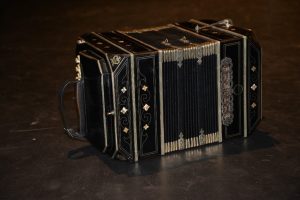
Here is what a bandoneon looks like out of its case. |
The predecessor of the bandoneon is another German instrument known as the concertina. The bandoneon is a ‘hand-organ-like’ reed instrument and has button keys on both sides. It belongs to the concertina and accordion family and it is sometimes referred to colloquially as a squeezebox. Heinrich Band played the concertina but felt frustrated with its limitations. This led him to create a more advanced version of the instrument that could be used to play new styles of German music and that could have the capability of replacing an entire church pipe organ. While the concertina was mostly played to accompany German folk music songs, the bandoneon was originally intended to be an instrument used in church music.
Circa 1870―about ten years after Heinrich Band’s death―German sailor emigrants brought the bandoneon to Argentina and Uruguay. In the Río de la Plata[3] region the name changed from the German “bandonion” to the Spanish “bandoneon.”[4] Once it arrived on the Southern Cone shores, the bandoneon soon found its true destiny in a new type of music and dance that was developing in Argentina and Uruguay known as tango. Before long, the bandoneon became the chief instrument and the main symbol of tango music.
Tango originated in the mid-1800s and early 1900s when South America’s Southern Cone experienced massive immigration by the millions. European migration to Argentina and Uruguay during the nineteenth century and the beginnings of the twentieth century happened mainly to escape the horrors of war and poverty in Europe.[5]
Tango is an urban musical style that emerged in the lower-class neighborhoods of the two port capital cities of the Río de la Plata region: Buenos Aires (Capital of Argentina) and Montevideo (Capital of Uruguay). It is safe to say that tango would have never been born without the influences of immigrants who arrived in Argentina and Uruguay in the mid-1800s and early 1900s. Most immigrants came from Italy and Spain, but there were also immigrants from Germany, France, England, Poland, Russia, Lithuania, Armenia, Africa, etc.[6] Actually, in the late 1980s tango was known in the Río de la Plata as the music of the immigrants. Tango is the result of a combination of German waltz, Czech polka, Polish mazurka, Bohemian Scottish music, Spanish-Cuban habanera, African candombe[7] and also Argentine local music such as milonga which is a lively musical genre that originated in the Río de la Plata and was popular in the 1800s. Milonga derived from an earlier style called payada contrapunto that consisted of competitive composing and singing of verses in a lively 2/4 tempo.[8]
Although tango started in the impoverished Río de la Plata neighborhoods, it soon spread rapidly reaching the core of Buenos Aires and Montevideo where people of all social classes started to engage in this dance and to enjoy this new musical genre. Tango’s popularity soon became unstoppable and it reached other countries such as Finland, Japan, France and the United States. In 2009, UNESCO[9] approved a proposal―signed by the governments of Argentina and Uruguay―to include tango in the UNESCO Intangible Cultural Heritage list.
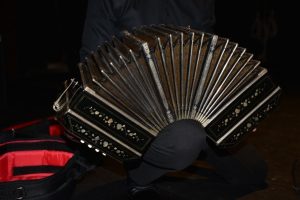 Troy Mattox with his bandoneon flexed across his knee. Troy Mattox with his bandoneon flexed across his knee.© 2018 New Dominion Media. |
Immigrants brought to the Río de la Plata their traditions, their culture, their music, and—as we already explained—also their original musical instruments such as the bandoneon. This instrument became the perfect match for this emerging urban musical genre called tango. The bandoneon has had entirely urban referents in South America ever since it arrived in the Southern Cone and got associated with tango.[10]
In my opinion, something extraordinary occurred when the bandoneon “migrated” from Germany to the Río de la Plata. This migration story reveals a perfect “kairos”[11] moment in the history of music. In fact, the bandoneon “migrated” to the Río de la Plata when tango was emerging. The conditions were right, and time was opportune for bandoneon and tango to find each other and to flourish together. In the streets of Argentina and Montevideo, bandoneon met tango and they both immediately became inseparable. This is a perfect “marriage” in the history of music. This beautiful migration story is also a symbol of the beauty and creativity that can emerge when several cultural traditions come together in perfect harmony.
Many of the first bandoneon tango players were of African descent. Black musicians picked up the bandoneon as soon as it arrived in Buenos Aires from western Germany in the mid-1800s. The first documented bandoneon player was an African-Argentine named José Santa Cruz who was a soldier in the War or the Triple Alianza.[12] The first master of bandoneon in Buenos Aires is believed to have been an African-Argentine virtuoso named Sebastián Ramos Mejía affectionately known as “El Pardo.”[13] By day Mejía drove a horse-drawn tramway in Buenos Aires and by night he played the bandoneon. In 1903 he taught an incredibly young Vicente Greco how to play the bandoneon. Greco, who became a very recognized composer, was one of eight children of a modest means couple of Italian descent. Soon European immigrants from all ethnicities and walks of life embraced this beautiful instrument and tango music.
As far as gender is concerned, most bandoneon players have traditionally been men. However, an early twentieth century picture reveals women playing the bandoneon as part of an Argentine female orchestra that performed for coffee shops, weddings, parties and dances.[14] But for the most part, the bandoneon remains an instrument associated with masculinity. Women who currently play the bandoneon feel a special sense of pride for defying social norms. Susana Ratcliff, an Argentine female bandoneon player, shared that men look indeed surprised when they see her walking around Buenos Aires with a bandoneon case. This reaction of people is gratifying to her because it makes her feel as if she is indeed “stealing” or claiming the bandoneon.[15]
As tango developed, the demand for bandoneons also increased. In fact, bandoneons became an integral part a tango orchestra (orquesta típica) and of tango ensemble bands which traditionally consist of at least two bandoneons, two violins, a piano, a flute and a double bass. Small tango ensembles with fewer instruments are also common. The bandoneon can also stand on its own as a solo instrument or accompany singers.
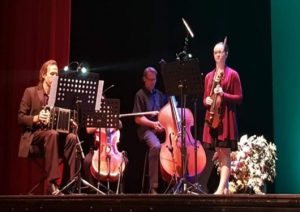
Troy Mattox, his bandoneon and his orchestra. |
Tens of thousands of German bandoneons were manufactured around 1910 primarily to be exported to Argentina and Uruguay, while some bandoneons were also shipped to Lithuania where the instrument became popular in folk music ensembles. The number of bandoneons shipped to the Southern Cone soared rapidly as tango music became increasingly popular. For instance, in 1930 alone 25,000 German made bandoneons were imported to Argentina. But despite the popularity of tango music, bandoneon mass production eventually decreased because of the disruption of German manufacturing during World War II. Consequently, the prices of bandoneons increased dramatically and eventually there were no more German bandoneons for export.
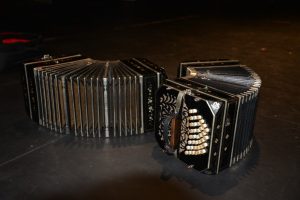 Troy’s bandoneons are laid out for a photo display. Troy’s bandoneons are laid out for a photo display.© Copyright 2018 New Dominion Media |
There are two main types of bandoneons: The chromatic which produces the same notes whether the bellows are opening or closing, and the achromatic, where opening and closings varies the expression, producing different sets of sounds. The bandoneon is played with both hands; finger keys control the opening of free reeds, while the movement of the hands produces air pressure that is captured in the central bellows of the instrument. When playing the bandoneon, the timbre constantly changes, depending on the air pressure, direction of the bellows and choice of keyboard for the melody and accompaniment. It is usually played sitting down because of the size, weight, and almost perfectly square shape. Because of the bandoneon rough edges, bandoneonists usually place a cloth on their legs to protect their clothes when playing the instrument. The playing position enables a much more powerful accentuation than it would be feasible on an accordion or on a concertina. The bandoneon’s intensity characteristic of tango is produced by the way the reeds “overblow”, generating an edge to the note that cannot be reproduced on other free reed instruments.[16]
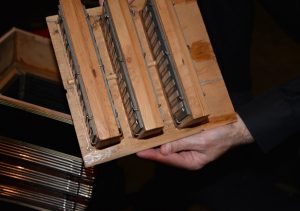 Troy Mattox shows us what the internal bandoneon reeds look like. Troy Mattox shows us what the internal bandoneon reeds look like.© 2018 New Dominion Media. |
Despite the bandoneon’s popularity in tango music, the instrument was seldom produced in Argentina. In 1944 a rare effort to produce a local bandoneon was made by the Argentine Society of Composers and Performers. This Argentine made bandoneon was tested by the great Aníbal Troilo. The Argentine musician Aníbal Troilo[17] (1914-1975) was the leading twentieth century bandoneon virtuoso, tango composer and tango band leader. Despite this attempt to locally make a bandoneon, musicians continued to prefer the craftsmanship, sound and exquisite quality of the authentic German bandoneon.
By the 2000’s classic German bandoneons became increasingly scarce and therefore extremely expensive, which discouraged many aspiring musicians of becoming bandoneon players. This critical shortage of bandoneons led the National University of Lanús in Argentina to pilot a project to manufacture locally made bandoneons.[18] As part of the project, a vintage German bandoneon was unassembled to figure out how to produce a comparable and more affordable instrument in Argentina. This project was named “Proyecto Pichuco” in honor of Argentine musician Aníbal Troilo who was affectionately known as “Pichuco.”
In 2014 the University of Lanús announced the successful development of an Argentine made bandoneon. By 2017 “Proyecto Pichuco” developed five bandoneons, and about forty more are being produced to be used in local high schools. The bandoneons produced by Lanús University (as of 2018) are still not for sale to the public, but the hope is to eventually produce more locally made bandoneons and to market them for about half of the cost of a vintage bandoneon.
The production of new bandoneons is extremely important for the future of tango music. But the magic and mystery of the vintage German bandoneon will probably never be matched. Vintage original instruments are displayed in German museums, such as the Bandoneon Museum of the family Preuss in Lichtenberg and the collection of the family Steinhart in Kirchzarten, Freiburg.
Rodolfo Mederos, a bandoneon player from Buenos Aires shared these thoughts regarding the instrument:
It was made and developed in Germany, at a time when things were meant to last, a time when plastic didn’t exist. The materials were noble: wood, metal, leather, mother of pearl, were all used in its construction […] For a bandoneonist, the instrument becomes one’s alter ego, it’s partly oneself. One feels possessed and possessor.[19]
As we expressed before, variations of tango are currently popular worldwide. For example, tango music and its soulmate, the bandoneon, are becoming increasingly popular in the United States. I recently had the pleasure to meet a musician who plays tango music and also dances the tango: American bandoneon player Troy Mattox who lives in Richmond, Virginia. Music has been an important part of his life since he was about ten years old. Mr. Mattox has been a musician for many years and plays several instruments. About playing the bandoneon Troy said:
The bandoneon has a unique soul that cannot be replicated with anything else. It is unique, it is rare, and it sounds just magnificent. I would say that is one of these things that drew me to bandoneon is its unique sound that you cannot get from any other instrument. You can say that about other instruments but there is something special about an instrument that was originally made to be a replacement for an entire pipe organ in a church. It is a portable church organ […] It is powerful, it is extraordinarily complex, and it is exceedingly difficult to learn.[20]
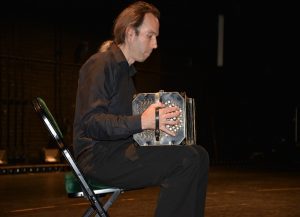
Troy Mattox gives us a ‘sneak preview’ of the sounds of his bandoneon. |
The beauty of bandoneon is mostly in its power and complexity. It provides a somber, sensual, and unusual sound. It is also beautiful and mesmerizing to observe a bandoneonist playing this enigmatic instrument with passion and love for tango. But the beauty of bandoneon is also in its history; in the journey of migration that culminated in the “marriage” of bandoneon to tango. This was a true “kairos” moment in history that changed and shaped the course of Southern Cone music; A love story that has lasted and will continue to last forevermore.
The reciprocal adaptation of tango (which is the result of a combination of music from different parts of the world) to the original German bandoneon, and of bandoneon to tango, also symbolizes the magnificent melting pot of cultures that occurred in Latin America in the mid-1800s and early 1900s. This process of assimilation and integration of cultures and races facilitated the emergence of new colorful national identities. You can have a sample of this brave new world when you listen to tango. Have you ever heard Argentine or Uruguayan tango music? Then you probably heard the enigmatic, unique, sensual, big-hearted and bouncing sound of a bandoneon![21]
Footnotes:
[1] The Southern Cone (Spanish: Cono Sur) is a geographic and cultural region composed of the southernmost areas of South America, south of and around the Tropic of Capricorn. Traditionally, it covers Argentina, Chile, and Uruguay. Southern Brazil and Paraguay are sometimes also included in the definition of Southern Cone.
[2] Geuns, Harry. “Heinrich Band” In: Bandonion History and Collection. Sept. 3, 2014,
http://bandoneon-maker.com/bandonion-history-collection/history-3 (cited on June 7, 2020).
[3] Río de la Plata (literally: “River of Silver”) is translated as “River Plate” in British English and the Commonwealth and “La Plata River” (Occasionally “Plata River”) in other English-speaking countries. It is formed by the confluence of the Uruguay and Panamá rivers and empties into the Atlantic Ocean. Depending on the geographer, the Río de la Plata may be considered a river, an estuary or a marginal sea. In Uruguay and Argentina, it is usually considered a river and, therefore, the widest river in the world with a maximum width of 140 miles.
[4] In Spanish “bandoneon” carries an accent mark on the “o”: “bandoneon.” The plural of “bandoneón” in Spanish is “bandoneons.”
[5] Thompson, Robert Farris. Tango: The Art History of Love. New York: Vintage Books, 2005.
[6] Oness, Liquidli. “History of Tango: Origins and Characteristics of Tango.” In: Dance Facts, 10. Jan. 2020, http://www.dancefacts.net/tango/history-of-tango (cited on July 9, 2020).
[7] Alisky, Martin. “The Arts.” In Uruguay. 1. Jan 2020, http://www.Uruguay – Education | Britannica (cited on June 10, 2020).
[8] Bedinghaus, Treva. “What is Milonga.” In Performing Arts. Feb. 25, 2019, http://www.Milonga: Social Event, Tango Style and Music Genre (liveabout.com) (cited on July 15, 2020).
[9] UNESCO: United Nations Educational, Scientific, and Cultural Organization.
[10] Thompson, Robert Farris. Tango: The Art History of Love. New York: Vintage Books, 2005.
[11] Kairos is an Ancient Greek word that means the right, critical, or opportune moment. The ancient Greeks had two words for time: chronos and kairos. While chronos makes reference to chronological or sequential time, kairos refers to a proper or opportune time for action.
[12] The War of the Triple Alianza is also called Paraguayan War, Spanish Guerra de la Triple Alianza, or Portuguese Guerra da Tríplice Aliança, (1864 – 1870), was the bloodiest conflict in Latin American history, fought between Paraguay and the allied countries of Argentina, Brazil, and Uruguay. The war ended with the defeat of Paraguay.
[13] Reid Andrews, George. The Afro-Argentines of Buenos Aires: 1800-1900, Madison, Wisconsin: University of Wisconsin Press, 1980.
[14] Collier, Simon, et al. Tango: The Dance, the Song, the Story p.121. New York: Thames and Hudson, 1995.
[15] Collier, Simon, et al. Tango: The Dance, the Song, the Story p.113. New York: Thames and Hudson, 1995.
[16] Benedetti, Héctor. Nueva Historia del Tango. Buenos Aires: Siglo XXI Editores, 2015.
[17] Besides Aníbal Troilo, the other most famous bandoneon virtuoso of all times was the Argentine Astor Pantaleón Piazzolla (1921-1992). Like Troilo, Piazzolla had Italian roots. Astor Piazzolla was a tango composer, bandoneon player, and arranger. He revolutionized traditional tango by creating a new style known as Nuevo tango (new tango), which incorporated elements from jazz and classical music. Piazzolla performed several of his own compositions with a variety of ensembles.
[18] Deasy, Kristin. “A Short History of the Bandoneón.” In: Culture Trip. June 9, 2017. https://theculturetrip.com/south-america/argentina/articles/a-short-history-of-the-bandoneon (cited on July 6, 2020).
[19] Collier, Simon, et al. Tango: The Dance, the Song, the Story p.113. New York: Thames and Hudson, 1995.
[20] This interview with musician Troy Mattox was conducted by Dr. Gabriela Christie Toletti on June 24, 2018 at the Roper Performing Arts Center in Norfolk, Virginia after a rehearsal for a September 2018 TCC Hispanic Heritage Month event planned by Dr. Christie Toletti for the launch of her book On the Scene with Migration and Dictatorship: An Interdisciplinary Approach to the Work of Uruguayan Playwright Dino Armas, Norfolk: New Dominion Press, 2018.
[21] Illustrations: Images of musician Troy Mattox and his bandoneons were taken at the Roper Performing Arts Center in Norfolk, Virginia on June 24th, 2018 (Rehearsal), and September 27th, 2018, as part of Dr. Gabriela Christie Toletti’s book presentation of On the Scene with Migration and Dictatorship: An Interdisciplinary Approach to the Work of Uruguayan Playwright Dino Armas, Norfolk: New Dominion Press, 2018. Pictures were taken by Charles Cody Christie Jr. Image of tango ensemble, September 27th, 2018, during that book presentation. In the picture: Mark Denison, Tidewater Community College Music Professor & Music Chair (Double Bass), Marissa Resmini, TCC student (Violin) and musician Troy Mattox (Bandoneon). Tango ensemble picture credit, Gabriela Toletti.
